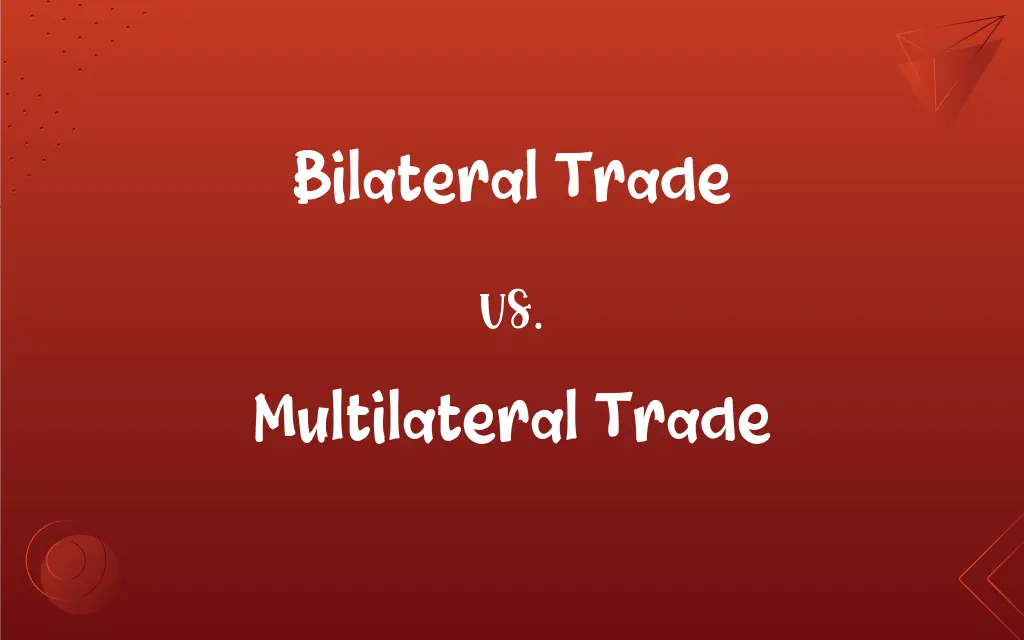Bilateral Trade vs. Multilateral Trade: What's the Difference?
Edited by Aimie Carlson || By Harlon Moss || Published on December 25, 2023
Bilateral trade refers to trade agreements between two countries. Multilateral trade refers to trade agreements involving more than two countries.

Key Differences
Bilateral trade refers to the exchange of goods and services between two specific countries, typically governed by a trade agreement or treaty specific to those two nations. Multilateral trade, in contrast, involves multiple countries and is often facilitated by broader agreements or international trade organizations.
In bilateral trade, negotiations and terms are tailored to the needs and interests of the two countries involved, allowing for more focused and specific agreements. Multilateral trade negotiations, however, must consider the interests and policies of multiple countries, making them more complex but potentially more inclusive.
Bilateral trade can lead to stronger bilateral relationships and can be more easily managed due to the involvement of only two countries. Multilateral trade opens up markets and trade possibilities among several countries, promoting greater economic integration and diversity of trade partners.
Bilateral trade agreements can sometimes lead to dependencies between the two countries involved. Multilateral trade agreements, by involving more countries, can reduce the reliance on any single trade partner and distribute trade risks more broadly.
Bilateral trade is often quicker to negotiate and implement, as it involves fewer parties. Multilateral trade, though more complex, can lead to more significant impact on global trade patterns and international economic policies.
ADVERTISEMENT
Comparison Chart
Number of Countries Involved
Two
More than two
Negotiation Complexity
Less complex, more focused
More complex, broader scope
Economic Impact
Specific to the countries involved
Wider, global impact
Trade Dependency
Higher between two countries
Lower, spread among multiple countries
Implementation Speed
Generally quicker
Slower due to complexity
ADVERTISEMENT
Bilateral Trade and Multilateral Trade Definitions
Bilateral Trade
A two-country-focused trade relationship.
China and Germany's bilateral trade includes machinery and automotive parts.
Multilateral Trade
A global or regional trade arrangement involving multiple countries.
Multilateral trade in ASEAN promotes regional economic integration.
Bilateral Trade
A specific trade agreement between two nations.
Bilateral trade agreements can streamline customs procedures between the involved countries.
Multilateral Trade
International trade agreements encompassing several nations.
Multilateral trade agreements under the WTO involve numerous countries.
Bilateral Trade
A mutual exchange of goods and services between two nations.
Bilateral trade between Japan and Australia includes technology and agricultural products.
Multilateral Trade
Broad-based international trade relations.
Multilateral trade contributes to the globalization of the world economy.
Bilateral Trade
Economic transactions involving two countries exclusively.
Bilateral trade deals often focus on tariff reductions between the two countries.
Multilateral Trade
Trade involving more than two countries under a common agreement.
The European Union participates in multilateral trade with many non-EU countries.
Bilateral Trade
Trade conducted directly between two countries.
The U.S. and Canada have a significant bilateral trade agreement.
Multilateral Trade
Collective trade negotiations among several countries.
Multilateral trade discussions often focus on reducing global trade barriers.
FAQs
What is bilateral trade?
Trade agreements and exchanges between two specific countries.
How do bilateral trade agreements work?
They involve negotiations between two countries to set trade terms, tariffs, and policies.
What is multilateral trade?
Trade involving more than two countries, often under international agreements.
What are examples of multilateral trade organizations?
The World Trade Organization (WTO) and regional bodies like ASEAN.
Can a country engage in both bilateral and multilateral trade?
Yes, countries often participate in both types of trade simultaneously.
Does multilateral trade reduce trade barriers more effectively?
Often, yes, as it involves agreements across several countries.
How does multilateral trade affect global markets?
It can lead to more interconnected and diverse global markets.
Do multilateral trade agreements impact national sovereignty?
They can, as countries must sometimes align national policies with international agreements.
How does bilateral trade impact economies?
It can strengthen economic ties and trade efficiency between two nations.
Can bilateral trade lead to economic dependency?
Yes, as it involves closer trade relations between two countries.
What are the challenges of bilateral trade negotiations?
Balancing national interests and addressing specific bilateral issues can be challenging.
Are bilateral trade agreements easier to negotiate?
Generally, yes, due to involving fewer parties and more focused interests.
What is the role of diplomacy in bilateral trade?
Diplomacy is crucial in negotiating and maintaining bilateral trade agreements.
What are the benefits of multilateral trade?
It promotes broader economic integration and can lead to global trade liberalization.
How do tariffs play a role in bilateral trade?
Tariffs are often key negotiation points in bilateral trade agreements.
Are bilateral trade agreements more focused on specific sectors?
Often, they are tailored to specific industries or sectors relevant to the two countries.
How do countries resolve disputes in multilateral trade?
Through mechanisms provided by the multilateral agreements or organizations like the WTO.
Can bilateral trade agreements evolve into multilateral ones?
Yes, bilateral agreements can sometimes expand to include more countries.
How does multilateral trade address global issues?
It can address issues like environmental standards and labor rights on a broader scale.
Can multilateral trade lead to standardization of trade practices?
Yes, it can lead to more uniform trade standards across multiple countries.
About Author
Written by
Harlon MossHarlon is a seasoned quality moderator and accomplished content writer for Difference Wiki. An alumnus of the prestigious University of California, he earned his degree in Computer Science. Leveraging his academic background, Harlon brings a meticulous and informed perspective to his work, ensuring content accuracy and excellence.
Edited by
Aimie CarlsonAimie Carlson, holding a master's degree in English literature, is a fervent English language enthusiast. She lends her writing talents to Difference Wiki, a prominent website that specializes in comparisons, offering readers insightful analyses that both captivate and inform.






































































